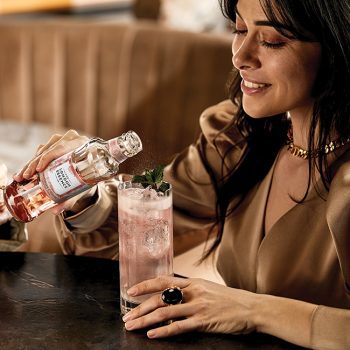Can tonic survive the gin slump?
By Claire DoddBuoyed by the gin boom, tonics and mixers surfed the crest of a wave. But as the popularity of that spirit wanes, brands are having to adapt to new trading conditions.

*This feature was originally published in the April 2024 issue of The Spirits Business magazine.
Everything is bigger in the US, right? Premium mixers may have been born in the UK, but it’s increasingly clear that the US is being eyed as the category’s next cash cow.
Fever-Tree saw revenue rise by 6% last year as the US overtook the UK to become the group’s biggest market. The UK-headquartered company saw revenue rise by 9% in the first half of 2023, with sales in the US climbing by 40%. Tellingly, it extended its position as the number-one brand by value in tonic and ginger beer, according to Nielsen data.

What makes the market so compelling? Is there life in the gin boom? “Gin is still a big driver of the mixer category,” says Benedikt Fimpel, head of sales export for German mixer brand Thomas Henry. “Gin is growing and premiumising [in the US], especially driven by increasing demand for smaller, craft brands and premium brands, which drives mixer upgrades. While we see a stagnating gin category in Europe, there is further growth expected in the Americas, as in Asia.”
Growth opportunities
Although there are clear growth opportunities, things are not so simple. “The US consumer is really different,” says Ounal Bailey, co-founder of The London Essence Co. The brand entered the US market three years ago, targeting the top end of the on-trade, particularly in Miami and New York. Despite the US spirits market being sophisticated and fast moving, mixer brands have until recently barely had a presence, says Bailey, with most serves coming from a soda gun. Packaged, let alone premium mixers, are something new. The potential market, then, is substantial.
 “In basic spirit terms, about 25% of alcohol consumption comes through spirits in Europe, whereas in the US it’s 46%,” she adds. “It’s a much more spirit-forward market, and is probably about four times the size of the UK. But for mixers it’s less evolved.
“In basic spirit terms, about 25% of alcohol consumption comes through spirits in Europe, whereas in the US it’s 46%,” she adds. “It’s a much more spirit-forward market, and is probably about four times the size of the UK. But for mixers it’s less evolved.
“Though the premiumisation trend is there in spirits, for mixers it isn’t quite yet. So if you’re trying to create a consumer-facing brand, it’s a challenge for retail. It’s early days for us, but we’re not trying to be consumer-facing. The US is great in terms of building our credibility or recognition among the top-end bars. Then we can work out in the future what we might do with that.”
Another brand looking to ‘break America’ is Franklin & Sons. With 80% of Global Brands’ international exports accounted for by the brand, it’s a vital part of the portfolio. Launched in the US three-and-a-half years ago, its total volumes in the US are currently up by 23% year-on-year, albeit from a smaller base than the market leader, says Keith Beattie, Global Brands’ director of sales, international.
For the US it has appointed new sales partner, Cascadia Managing Brands, and Rodeo CPG to break grocery. “It was a tough start,” says Beattie. “We’ve seen some good stats on gin, particularly flavoured gin in the US, which gives us hope that maybe the gin boom is about to finally catch on over there. It’s a long road for us. But the prize for the brand is huge.
“Fever-Tree’s figures show there is a huge opportunity in the US. It’s been a harder play to educate the bar scene in terms of that premiumisation with the bottle serve. And though it needed one brand to create it, a category isn’t going to be made by just one brand alone. Now there’s space for us and other brands to come in and take some premium space. It’s a huge opportunity, a huge challenge, but one that we’re embracing fully.”
Its strategy for doing that in a market dominated by tonic and ginger mixers, may be a little different than that of other players, however. “We’re very much focused on being beyond tonic,” adds Beattie. “A lot of our more, let’s call them interesting flavours, like Mandarin & Ginger Soda, or Pineapple & Almond Soda are leading the way in the US. They get us through the door.”
Volatile market
But the market is volatile. And while embracing spirit trends – such as the rise of Tequila sales, and a surge in demand for grapefruit mixers in a number of markets – future proofing against their fall has also become essential. In the US and beyond, brands have been positioning their products increasingly as a standalone option for when consumers chose not to drink alcohol.

In late 2021, Gossip Girl actor Blake Lively launched Betty Buzz in the US. Made with ‘real’ juice and ‘natural’ flavours, the range is free from artificial flavours, colours, or sweeteners. It debuted in the UK in May 2023. “What’s been quite interesting for us is that when Betty Buzz was launched [in the US], it was seen quite predominantly as a mixer,” says Gareth Williams, global brand director at Betty Buzz. “We soon found out that the US gin category wasn’t in the same place as the rest of the world, and that the way Betty Buzz was being drunk was more as an adult soft drink, on its own. So we had to pivot our thinking. We wouldn’t outwardly now call it a mixer, we call it a premium adult soft drink that can be mixed.”
Williams adds: “Since we launched in the UK, we’ve seen a big decline in gin sales. That’s really affecting the market, which means we’re starting to copy what we’ve been doing in the US.”
Focus on flavours
With tonic a slow mover for the brand in the UK, the company has decided to focus on flavours such as Lemon & Lime, Pink Grapefruit, and Ginger Beer, which mix well with Tequila and vodka, especially when it moves into mainland Europe later this year, starting with France, Switzerland, Belgium, and the Netherlands.
Alongside expansion to the UAE, new flavour Cherry Apple Blossom, is set to launch in the US, with a UK launch of its ready-to-drink cocktail brand, Betty Booze, also slated for this spring.
Meanwhile, in what Fimpel calls an “important strategic move” for Thomas Henry, the firm recently bought Undone, an alcohol-free ‘spirits’ and wine brand. There are new Thomas Henry variants planned too.
For the London Essence Co, the focus is firmly on the UK market. “If you’re in decline at home, you’re going to look elsewhere for growth,” says Bailey. “Those with an older consumer base have a challenge as those people are traditionally G&T drinkers.
“They need to branch out to secure growth elsewhere. We’ve got a great brand that we’re building at home. We’ve always looked beyond the G&T, and have tried to have a much wider range of products, and have more balanced sales. We bring in new, much younger consumers into the category, so we feel like we’re playing in the right dynamic.”
According to the company’s own data, 50% of the brand’s audience is under 55, with its biggest consumer group between 35 and 44. UK volumes are up by 13% year on year to March 2024, in a market where brands such as Fever-Tree and Schweppes are down. With the Paloma a hot serve, sales of its Pink Grapefruit Crafted Soda are particularly strong. “The landscape is tough at the minute. That’s probably the same for every brand and every category. But from a Franklins [& Sons] point of view, we’ve held up pretty well,” adds Craig Chapman, Global Brands’ head of brand, noting that the UK performance is seeing a flat off-trade, with on-premise sales currently up 4% year on year in volume. “Being an independently-owned brand is something that helps us,” he adds. “We can be quite reactive, and have a broad footprint that has helped soften the blow of the gin decline that we’ve all seen.”
As well as a range of flavoured tonics and soda waters, its 11 soft drink SKUs include everything from Dandelion & Burdock to Spring Rhubarb Lemonade, and Damson & Sweet Cherry. Its RTD line has seen it partner with brands including Manchester Gin, Portobello Road Gin, and RedLeg Spiced Rum. Pink Grapefruit Soda, launched in summer 2022, is up by 52% in volume for the period from October 2023 to the end of February 2024, with a big Paloma activation planned for this summer. Elsewhere, trending flavours by market include flavoured tonics in Eastern Europe, and flavoured sodas and soda water in the Middle East. What else lies ahead for the category? Deposit return schemes introduced or set to be brought in in various markets will be a challenge to smaller producers if requirements differ by market.
Hero serves
But for now, all eyes are on one big question; is there life after tonic? “Premium mixers are more than just tonic water and ginger ale,” says Fimpel. “We cannot blindly rely on a gin and tonic boom like what happened in Europe. It takes hero serves and plenty of education to establish new ways of mixing and to drive further growth in premium mixer category.”
And while the Paloma is looking like being a contender, another hero serve may yet be waiting in the wings.
Is the decline in gin sales in the UK affecting demand for premium tonic water? Which other markets are surprising you with their growth and potential?
Raissa de Haas – co-founder, Double Dutch
“The slowdown in premium gin has definitely had an impact on the tonic and mixer category. There has been a big push from brands to diversify their product portfolios, which we think is a direct effect of that. At Double Dutch, our approach has always prioritised flavour versatility, with products working for all spirits from the outset, a strategy that has proven advantageous as gin sales have slowed.
“While gin might have slowed down, the rise in consumption of Tequila, Asian spirits, and non-alcoholic ‘spirits’ has helped to counteract it, with new trends embraced by consumers, brands, and the hospitality sector alike.
“A shift towards embracing diverse spirits has consequently boosted tonic and mixer sales, with products like ginger beer finding new applications in trending cocktails such as the Moscow Mule, or our pink grapefruit in the Paloma. This diversification has been instrumental in mitigating the impact of the slowdown in gin and tonic sales.”
Craig Chapman – head of brand, Global Brands
“We saw the premium tonic category benefit hugely from the gin boom, so, naturally, as gin volumes decline there has been an impact on the category. However, we are seeing that flavoured tonics are proving more resilient because consumers are using mixers to experiment with flavours. We also see that there is growing demand being driven by other categories. As Tequila continues to grow, there’s been increased interest in our Franklin & Sons Grapefruit Soda as the Paloma rises in popularity.
“Globally, we are seeing the US developing as consumers there increasingly look for premium offerings, whether they be to mix with gin, or other spirits, such as vodka or Tequila.”
Marco Frizzarin – senior international brand manager, Thomas Henry
“We see a surprising additional growth for our brand in Central East Europe as well as the Benelux countries. Also, our key market, Germany, is already above plan, which is great for us to further consolidate our market leadership there.”
Related news
SB's 12 Drinks of Christmas: Planteray Rum
